Four Main Risks to Military Bases
The U.S. Department of Defense (DoD) maintains installations worldwide; worth over $1.2 trillion and critical to U.S. national security. Physical changes to the environment such as flooding, drought, and extreme storms disrupt U.S. military capabilities and facilities, including training ranges, bases, and housing. A 2019 DoD assessment found that out of 79 mission assurance priority installations, 67% currently face threats from flooding, 54% currently face threats from drought, and 46% currently face threats from wildfires. In the future that risk is anticipated to increase. Assessing the vulnerability of U.S. military infrastructure is critical to prepare for the current and future changes.
Sea Level Rise
Submerges our infrastructure
Sea level rise threatens U.S. military infrastructure in the U.S. and around the world. While location dependent, global sea level has already risen by over half a foot since 1880. It is projected to rise at least another 1 to 4 feet by 2100. While a few feet may not seem like much, in the U.S. nearly 5 million people live at less than 4 feet above high tide.
Coastal installations are flooding more often and are prone to damage from elevated storm surges. Increased flooding and storm surges undermine the readiness of the installation, threatening both physical assets and capabilities.
In addition, as sea level rises, the ground water at some installations is vulnerable to contamination from salt water intrusion. Contamination of the ground water could make some locations uninhabitable and create a new challenge for operations as fresh water must be shipped in. Kwajalein, home to the U.S. Army’s Ronald Reagan Ballistic Missile Defense Test Site, could be out of fresh water by 2035.
Examples
Hampton Roads Region
- The Hampton Roads region includes some of the most important and largest military bases in the world.
- Hampton Roads is uniquely vulnerable to sea level rise as the ground is simultaneously sinking due to the geological make-up of the region.
- Norfolk, Virginia, home to the world’s largest naval base, is predicted to see at least 2 – 5 feet of sea level rise by 2100 with the potential for up to 11 feet of sea level rise. Even 3 feet of sea level rise would seriously impact Naval Station Norfolk. 5 feet of sea level rise would completely submerge multiple piers at Norfolk and significant sections of runway at Langley AFB.
- Naval Station Norfolk already suffers from persistent, recurrent flooding – even on sunny days – due to tidal changes.
- The dry docks, used for repairs and maintenance on our military ships, are slowly being submerged.
- The base has begun to build new, double decker piers to allow maintenance workers to reach electrical cables, countering the sinking ground and rising seas.
- Each new pier costs over $100 million.
NOAA has mapped sea level rise along the coastal US. By increasing the predicted change in sea level, this map shows the impact of sea level rise on Naval Station Norfolk
Necessary Action/Opportunities
Invest in resiliency plans
- A 2019 GAO report found that the Department of Defense (DoD) is not sufficiently prepared for the impacts of sea level rise.
- The most vulnerable installations are already at risk and need to adapt or consider relocation.
Build new construction with climate change in mind
- Current regulations do not require new military infrastructure to be built based on future predicted sea level rise. This creates a known (and unnecessary) vulnerability to our new infrastructure.
- The DoD needs to prepare for the coming impacts by assessing the risk and providing concrete guidance on how to use climate projections in installation master plans.
Extreme Storms
Decimate our military bases
Storms are becoming more frequent and more extreme. Models project a 45%-87% increase in the frequency of Category 4 and 5 hurricanes along the East Coast of the United States. The combination of rising sea levels and increasingly extreme storms threatens infrastructure and capabilities on U.S. bases. Storms can decimate entire bases and the communities they rely on. Storms from 2018 cost the military almost $7 billion in rebuilding and unknown levels of readiness.
The U.S. military is also called on to respond to disasters worldwide. Time spent responding to disasters is time not focusing on traditional security threats. Further, servicemen and women and their families are put under additional strain as deployments last longer than anticipated. The mental and emotional toll on the individual should not be forgotten.
Examples
Tyndall Air Force Base
- In October 2018, Hurricane Michael slammed into Tyndall Air Force Base.
- Rebuilding will take years and is estimated to cost over $3 billion.
- As a result, the Air Force faced a $4 billion deficit, in part due to the damage at both Tyndall AFB and Offutt AFB.
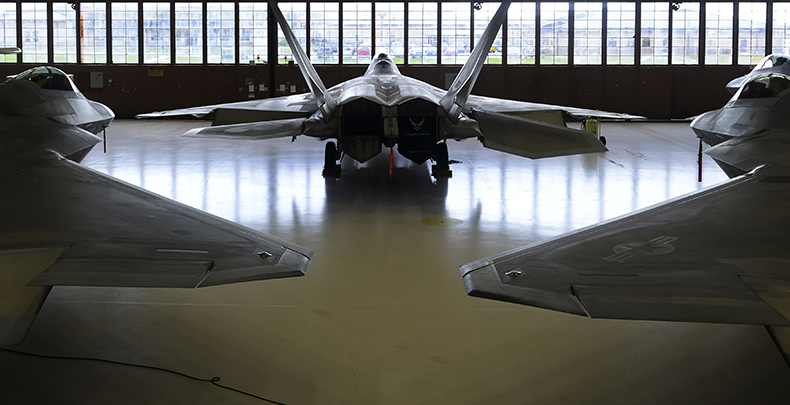
F-22s sit in a hanger at Tyndall Air Force Base prior to Hurricane Michael. Credit: U.S. Department of Defense
Camp Lejeune Marine Corps
- In September 2018, Hurricane Florence drenched North Carolina and caused significant damage at Camp Lejeune Marine Corps facility.
- Estimates suggest that the recovery at Camp Lejeune, Marine Corps Air Station New River, and Marine Corps Air Station Cherry Point will cost around $3.6 billion.
- US Marine Corps. Gen. Robert Neller said that he was forced to curtail or cancel several training exercises to free up funds for hurricane repair.
- Military personnel were also diverted from their scheduled deployment to respond to the hurricane, extending the deployment of servicemen and women in Norway and slowing the deployment of new units.
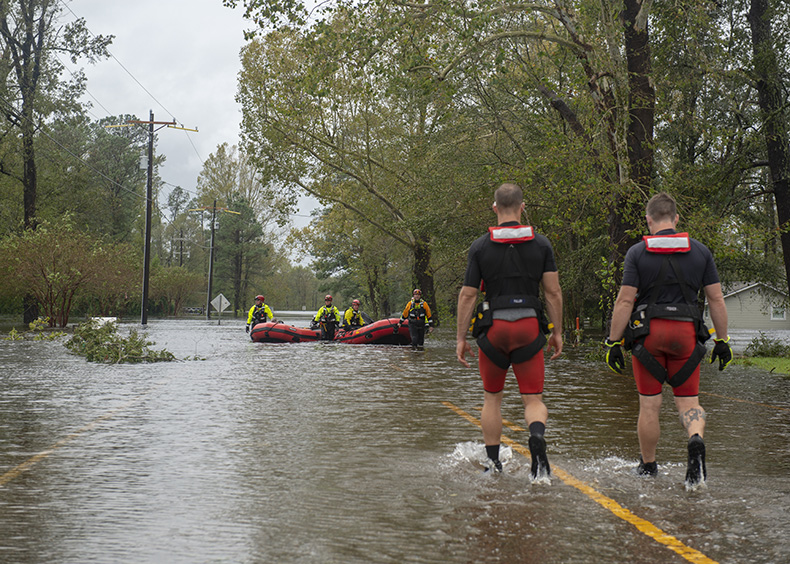
Recovery efforts after Hurricane Florence. Credit: U.S. Department of Defense
Necessary Action/Opportunities
Prepare bases both physically and financially for future storms.
- Bases will be more resilient to storms if they build the likelihood of increasingly extreme and frequent storms into their planning.
- Preparing now will lower the risk of bases going offline and financial deficits from rebuilding.
Continue humanitarian response training and assess capabilities
- While the services train for humanitarian response efforts, the services also must assess how many disasters they can simultaneously respond to.
Extreme Heat & Drought
Undermine Training and Readiness
As conditions around the globe become more arid and temperatures increase, training and readiness may be impacted, particularly at bases in the arid, Western United States.
Average annual temperatures have already increased by 1.9° F since 1970 and are projected to increase another 2.5°-6.5° F by 2050 in the Western U.S. Further, recent droughts represent the driest conditions in 800 years in the Western U.S.
The risk of wildfires and excessive heat restricts both training and the operations of the base. Dry conditions can force bases to limit or completely halt any live-fire training. In some cases, the base itself may be shut down if a near by wildfire threatens the installation.
In addition, bases rely on the local community for water. If the community runs out of water, the base is forced to use vital budget dollars to purchase and truck in water.
Mountain Home Air Force Base in Idaho relies on critically declining groundwater for its water supply. The installation intends to divert water from the Snake River, potentially impacting downstream communities.
Examples
- In 2021, Beale Air Force Base and Camp Pendleton in California were forced to evacuate as Western wildfires burned significant portions of land and housing.
- Vandenberg Air Force Base in California is the Department of Defense’s space and missile testing ground.
- In late 2016, a fire near the base covered over 10,000 acres and forced the closure of the South Base portion of the installation.
- The wildfire cost over $200 million in just firefighting costs and delayed a satellite launch from the base.
- Rising temperatures are causing a substantial increase in heat-realted illnesses among service members. In the coming decades, military installations could experience five times as many days reaching a heat index of 100ºF or more.
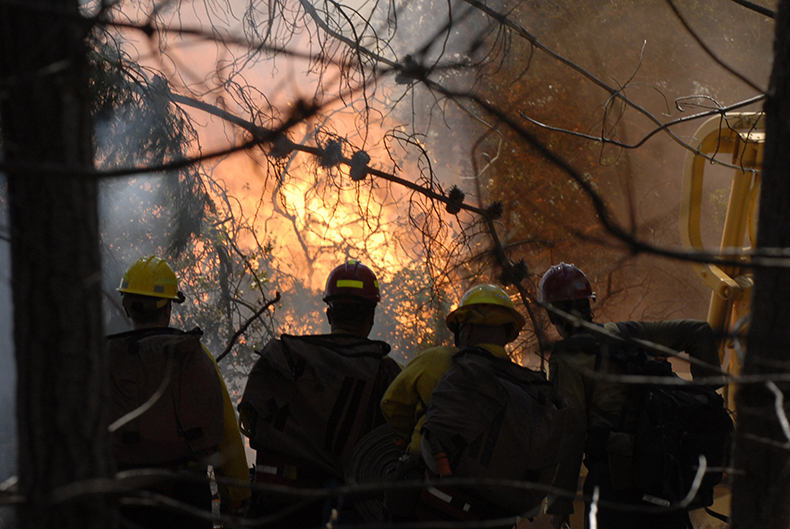
Firefighters at Vandenberg Air Force Base. Credit: Santa Barbara County Fire Dept.
Necessary Action/Opportunities
Conserve and preserve water supply
- Protecting local water supplies is critical for the base and local communities’ survival.
- Simply diverting water isn’t a long term solution as temperatures rise and sources deplete due to increased evaporation and overuse.
Assess impact of increased heat and wildfires
- A number of the U.S.’ critical training facilities are in desert environments across the Western U.S. The DoD must begin to track the number of training days lost due to heat restrictions or fire concerns and assess the impact of those days lost.
Arctic Ice Melt
Creates opportunities for our enemies
The Arctic is warming at twice the rate of the rest of the world. Models predict that the Arctic could be ice free as early as 2035. The National Oceanic and Atmospheric Administration found that in 2020, “The Arctic sea ice cover continues declining trends in the summer minimum and winter maximum extents. End of Winter extent was the 11th lowest and the end of summer extent was the 2nd lowest in the satellite record (1979-2020).
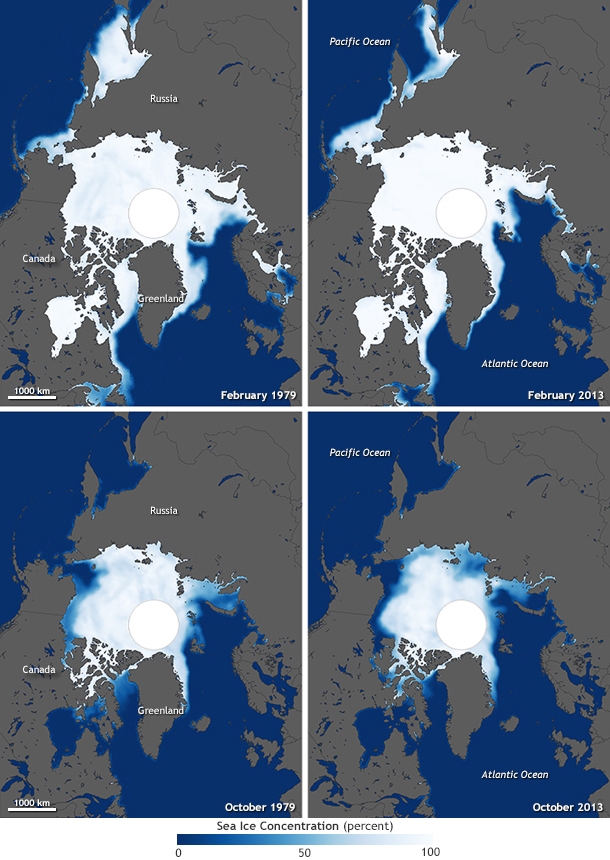
The above maps show the drastic change in ocean ice in the Arctic over the past few decades. Further melting is likely to continue to increase.
As the Arctic melts, there will inevitably be increased activity due to increased maneuverability. While the U.S. has ramped up exercises in recent year, the U.S. continues to lag behind Russia and other Arctic nations in preparedness and presence. The U.S. has significantly less capability in the Arctic and risks ceding leadership to Russia and China.
In 2021, the U.S. Navy released a report detailing their strategic blueprint for the Arctic, noting that “the region has the potential to connect nearly 75% of the world’s population.” Melting sea ice has led to an increase in transportation and shipping in the Arctic along new passages, like the Northern Sea Route. Russia adopted a 15-year plan for the region in 2019, which contains funding for infrastructure, exploration, and 40 new vessels including several nuclear icebreakers.
The U.S. military conducts a number of exercises in the region including Exercise Arctic Edge, a biannual, large-scale joint training exercise through U.S. Northern Command. But U.S. military installations in the Arctic are few and far between and are often susceptible to both coastal erosion and collapsing permafrost. Troops are still working to address the unique difficulties of communicating in the Arctic. Everything from ice on antennas to severe magnetic storms impacts radio communications.
The U.S. is in desperate need of a new icebreaker for operations in both the Arctic and Antarctic.
- Currently the U.S. has only one fully-functioning heavy icebreaker, the USCGC Polar Star. The second icebreaker, the USCGC Polar Sea, has been inactive since 2010 and is primarily used for spare parts for the Polar Star. A new heavy icebreaker is due to be completed in 2024.
- Russia has over 40 icebreakers and has been refurbishing military installations across the region. The Russians have also begun to develop air defense and various radar systems along the coastline.
- China has declared itself a “near-Arctic” nation and expressed a desire to expand its Belt and Road Initiative to include a “Polar Silk Road.” China currently has two icebreaking vessels and is in the process of constructing their first nuclear-powered icebreaker.
Examples
Cape Lisburne LRRS Airport
- Cape Lisburne in Point Hope, Alaska is home to the Long Range Radar program which detects foreign aircraft entering U.S. airspace.
- Coastal erosion is expected to have a significant impact on infrastructure by 2040. The station is working to fortify its runway but remains at risk.
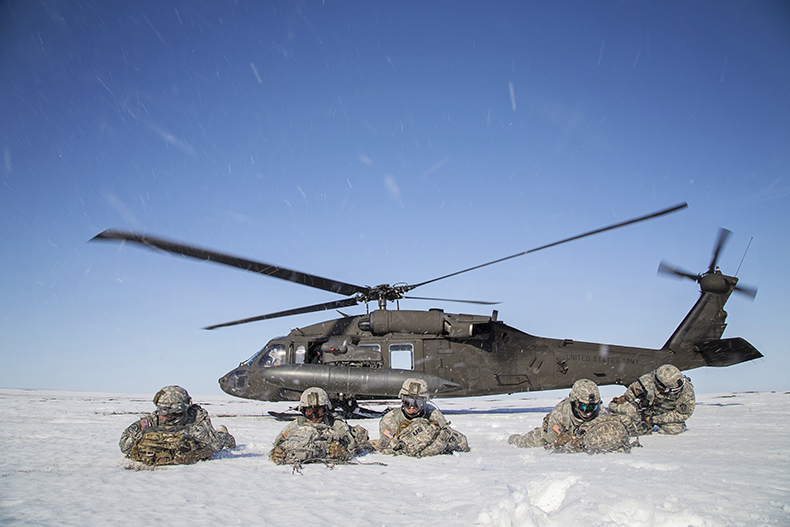
U.S. Army training in the Arctic. Credit: U.S. Department of Defense
Necessary Action/Opportunities
Training based on changing conditions
- Incorporate changing land conditions into training exercises in the Arctic. Training shouldn’t be based solely on current conditions.
Increase investment in the Arctic
- The U.S. needs to invest in additional icebreakers to maintain a presence in both the Arctic and Antarctic.
- Develop communication capabilities which can adapt to the challenges of the Arctic.
Header image credit: NOAA/JMA/NESDIS Environmental Visualization Laboratory. Image ID: spac0658, NOAA In Space Collection. Photo Date: 2015 July 6 2230 EDT.
